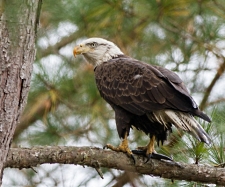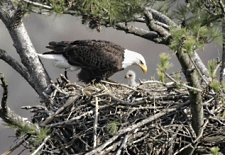Wildlife - Species

Status in SC: Imperiled (S2)
Southern Bald Eagle
The Bald Eagle was removed from the Endangered Species list in June of 2007 and receives protection by the Eagle Protection Act under the Office of Migratory Birds at the US Fish and Wildlife Service. It continues to be listed under the South Carolina Nongame and Endangered Species Conservation Act as a state endangered species. In South Carolina, the Bald Eagle is considered an imperiled species (S2) (Nature Serve 2012).
Current Legal Protections for Bald Eagles (USFWS)
Bald Eagle Management Guidelines and Conservation Measures (USFWS)

Southern Bald Eagle (Haliaeetus leucocephalus)
Description
Bald eagles are magnificent birds of prey. The bald eagle's common name comes from "balde," an Old English word meaning "white." Its scientific name, Haliaeetus leucocephalus, means "white-headed sea eagle." Actually, it is the only representative of the group of eagles known as sea eagles in the New World. Except for the rare golden eagle, the bald eagle is the largest raptor in South Carolina, with a wingspan of 180-230 cm (70-90 in). Adult bald eagles have dark brown plumage except for the head, neck, and tail, which are white. The birds' bill, feet, and eyes are yellow. Young eagles have dark to light brown plumage; their eyes and bill are also dark. The characteristic white plumage does not begin to develop until eaglets are 3 years old, and may not be complete until 5-6 years of age.
Preferred Habitat and Biology
Bald eagles build their nests in tall trees along coasts or on the banks of rivers and lakes. Suitable nest sites are chosen based on proximity to water, vantage point, and height of the tree. In South Carolina, eagle nests are often found in tall, live pines with a higher canopy than surrounding trees. Usually, nesting sites are close (within 1 mile) to large bodies of water such as impounded marshes. Each year during the breeding season, new branches are added to the original nest. Over time, bald eagle nests can measure 3 meters (10 feet) across and weigh more than 1 ton. Nesting in South Carolina occurs along the major river drainages of the Lower Coastal Plain. The ACE Basin constitutes the most important nesting area in the state, with 40% of nesting eagles living within its boundaries. In summer 1997, nesting bald eagles numbered 114 in 27 counties in South Carolina. This is a considerable increase from an initial 13 pairs in five counties when the South Carolina Department of Natural Resources began a monitoring program for this species 20 years ago.
Bald eagles mate for life. In South Carolina, eggs are laid in late December to early January. Male and female bald eagles take turns incubating the eggs that are laid in clutches of one to three. Eaglets hatch after approximately 35 days. In the spring and summer, juveniles and adults migrate north. Eagles banded in South Carolina have been reported to migrate as far north as Canada. However, the Chesapeake Bay area appears to be a favored location for South Carolina eagles during the non-nesting season. Bald eagles feed mainly on fish, which are snatched out of the water with the eagles' talons or stolen from ospreys. However, during winter eagles also feed on coots, injured ducks and, occasionally, rabbits and other small mammals. Carrion, usually dead fish, is a regular part of their diet.
Species Significance
In the past, eagles have been protected under the Eagle Protection Act of 1940, the Migratory Bird Treaty Act, and the Lacey Act. However, loss of habitat, indiscriminate shooting, and pollutants such as pesticides were primary factors contributing to the eagle's reduced numbers. Between 1947 and 1972, eagle populations throughout the country plummeted. Scientists determined that harmful chemicals, such as the pesticide DDT, were accumulating in the food chain and affecting top level predators. Birds that fed on fish contaminated with DDT residue laid eggs with very thin shells that broke easily before the eaglets could hatch. Since then, use of certain pesticides has been banned in the United States, and bald eagle populations are slowly recovering; their status changed from endangered to threatened in July of 1995.
References
Bull, J. L. and J. Farrand, Jr. 1995. National Audubon Society Field Guide to North American Birds. Eastern Region. The Audubon Society field guide series. Alfred A. Knopf Inc., New York, NY.
Heritage Trust Data Base. 1997. Heritage Trust Program, South Carolina Department of Natural Resources, Columbia, SC.
Murphy, T.M., Jr. and J.W. Coker. 1978. The status of the bald eagle in South Carolina. p. 89-93. In: R.O. Odom and L. Landers (eds.). Proceedings of the rare and endangered wildlife symposium, 3-4 Aug. 1978, Athens, GA. Georgia Department of Natural Resources, Game Division, Technical Bulletin WL 4. Atlanta, GA.
Murphy, S. H. and G. Barnette (eds.). South Carolina's endangered species portfolio. South Carolina Department of Natural Resources, Wildlife Diversity Section, Columbia, SC.
Sprunt, A., Jr. and E. B. Chamberlain. 1970. South Carolina bird life. University of South Carolina Press, Columbia, SC.
